Chashu pork is ridiculously easy to make at home. Rolled pork belly braised to delicious melt in your mouth perfection. The tender slices of charred goodness that crown a bowl of piping hot ramen. There is no excuse to not have some on hand in the freezer, and you can use it for more than ramen.
Pork belly cooked in this manner is incredibly tasty and tender. I keep a nice little hoard of the stuff in my freezer. Sliced and ready to use when needed, or I should say craved.
It goes perfectly with the stash of instant ramen I have in the cupboard. Add a few slices of chashu pork with some freshly chopped spring onion, egg, and pickled bamboo. Bingo, delicious easy ramen at home.
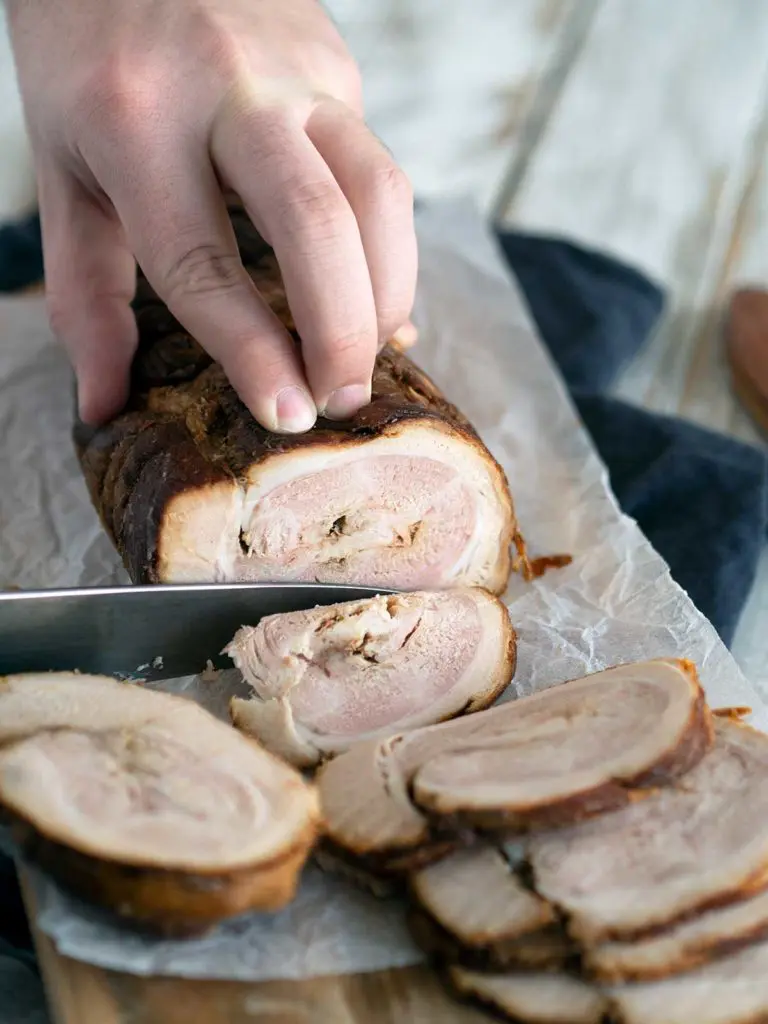
What's in this post
Not just for ramen
I do make chashu pork mainly to be used with ramen. Especially when the months are colder, and a warm bowl of noodles and broth go down a treat.
But there are many ways you can use this version of Japanese braised pork belly. You don't have to use it just for ramen.
- Okonomiyaki - A few slices placed on top of the ingredients when cooking. It will sear beautifully on the grill when flipping it over.
- Rice & Noodles - Add it as an ingredient to stir-fried noodles or fried rice.
- Baos (steamed Buns) - Place a couple of slices in a steamed bao with green onion, cucumber, and tonkatsu sauce.
- Donburi - makes a great topping for a donburi, rice bowl.
- Omelette - chop some up with green onion, baby corn, and bean shoots as an omelette filling.
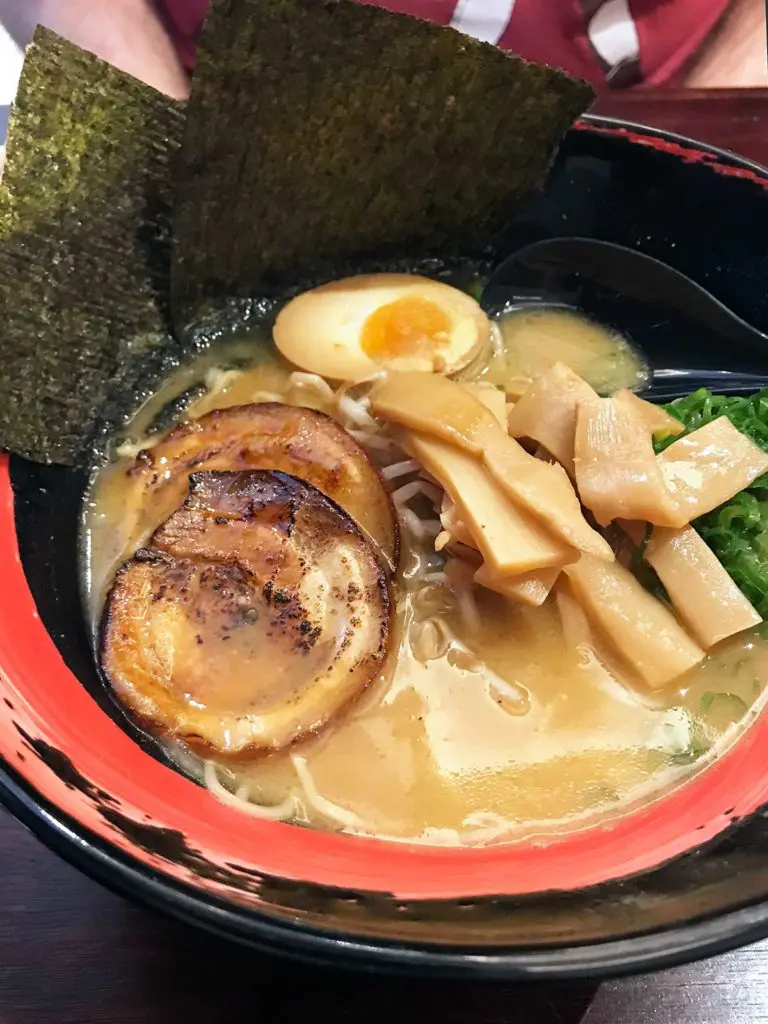
Preparing, rolling & tying the pork belly
I've used a 1.5kg (3.3 pounds) piece of pork belly for this chashu pork recipe. Both the skin and the bones have been removed. This is something I ask my butcher to do for me. Saves me having to do it, plus they are far better at butchering meat than I am.
Do keep the bones and skin. You may as well as you are paying for them in any case. The bones can be used to make broth (pop them in the freezer until you have enough).
The skin I turn into crackling. Also known as Sara made pork scratchings and the entire family (including Harley) do a happy dance.


With the underside of the belly facing up, roll it up as tight as you possibly can.


Tying up a rolled pork belly for the first time can be a little tricky. Don't worry about how tidy it looks, nobody is going to see it with the string on.
The idea is to keep it in a tight roll, nice and compact as the meat will shrink slightly during cooking.
Wrap kitchen string/butcher's twin around one end of the rolled belly. Tie a double knot to firmly secure the string. Loop the string around the belly a finger spacing away from your initial knotted loop. Thread the string under the loop just created and pull tightly. Continue this until you come to the other end of the belly.

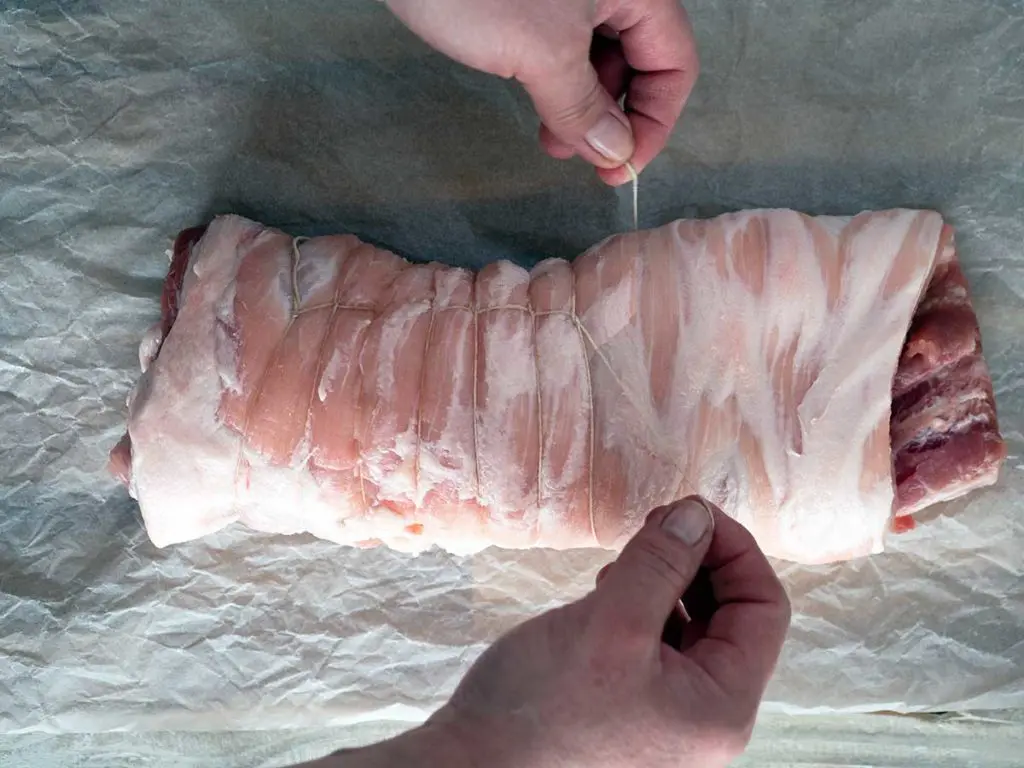

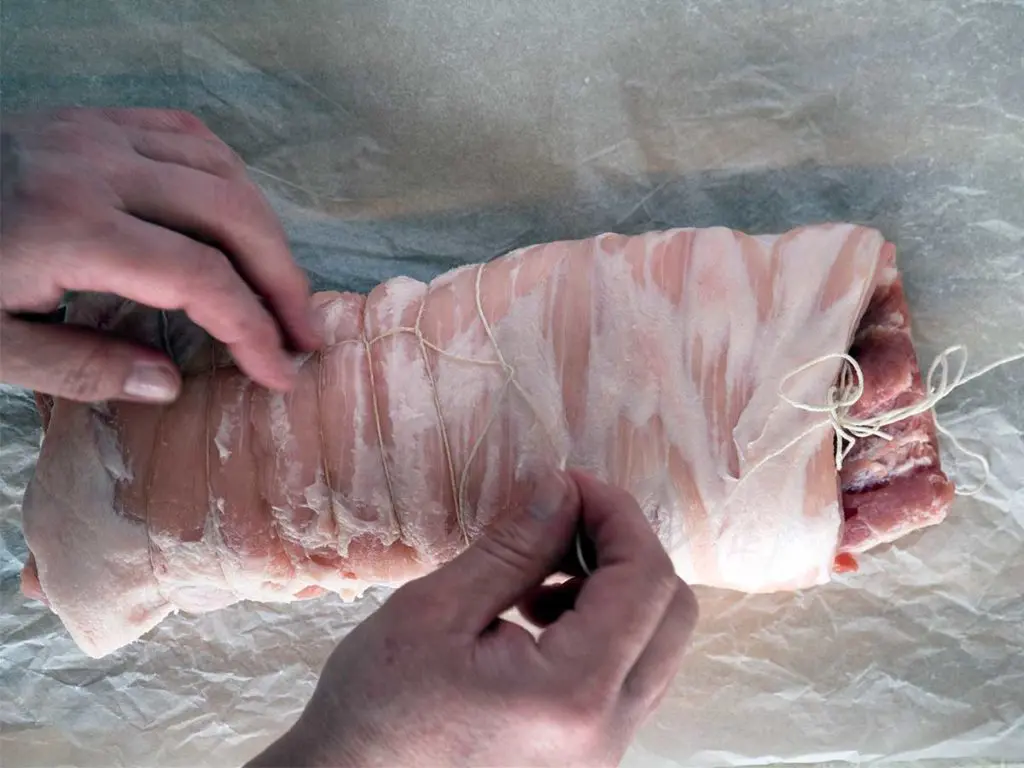
Once the string has been wrapped around the pork belly you need to secure the ends. Loop the string over the end of the pork roll, tucking in the end of the pork. Run the string down the middle of the roll, threading the string through every few loops as you go, pulling tight.
Do the same for the other side of the rolled and tied belly.
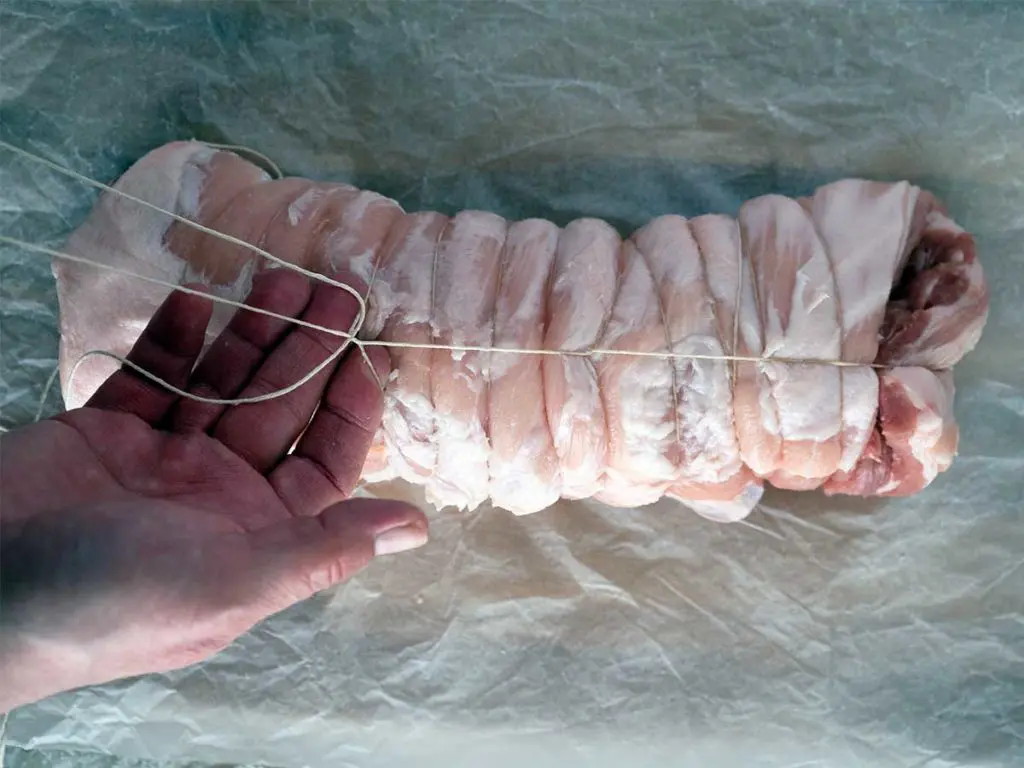

The importance of browning
Once the pork belly is tightly rolled you are on to the next stage, browning. Browning the chashu pork is very important, and not a step to skip. By browning the meat you are caramelising it, giving it not just colour, but also flavour.
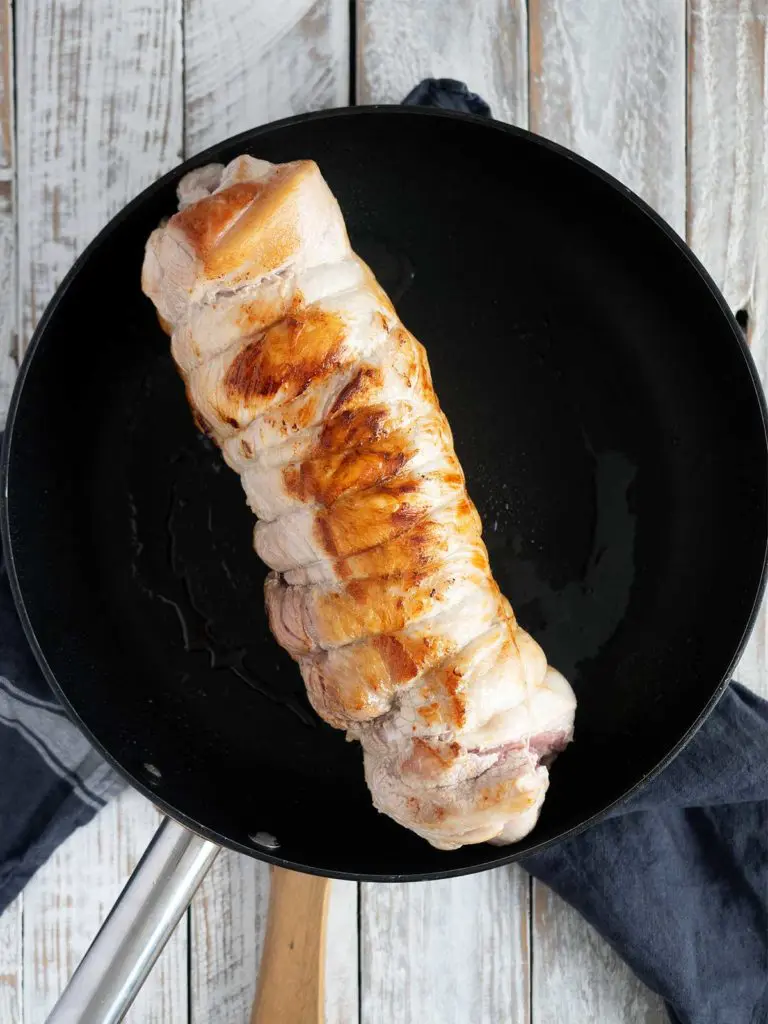
Braising liquid
Now it's on to the real part of the cooking. Braising the pork slowly in a flavour packed liquid for a few hours.
A classic Japanese flavour combination, mirin, cooking sake, soy sauce, sugar, garlic, ginger, shallot and green onion. Easy to obtain ingredients from your local supermarket or Asian grocery store.


What I do love about this recipe is that it keeps on giving. Not only do you end up with a decent amount of chashu pork, you also end up with a flavourful sauce. DO NOT throw the braising liquid away.
It is black gold! Use it to make Ajitsuke tamago (ramen eggs), as a sauce for stir-fries, marinade, noodle dipping sauce, or drizzled over chilled tofu. You can also use a little of the sauce to reheat slices of chashu pork.


Pour the leftover braising liquid into a large jug through a fine mesh sieve. Once cooled, cover and leave in the fridge overnight. The fat will come to the top and solidify. This makes it easy to spoon off the fat to discard.
Pour into glass jars and store in the fridge.
Slicing & storing
Now we come to the hard part. Once the chashu pork has finished cooking it needs to cool and "set". Once cooled wrap it tightly in a few layers of plastic wrap. Then place in the fridge overnight.
If you try to slice the chashu pork immediately after it has been cooked it will shred to pieces. It needs time in the fridge to completely chill and set in the rolled shape.


The next day, and it is worth the wait, you are ready to slice up your ramen pork belly.
Carefully remove the kitchen string before slicing. Using a sharp knife cut. into 2-3mm (⅛ inch) slices. The ends are difficult to slice, chop those up to use in fried rice, with noodles, or topping a donburi.
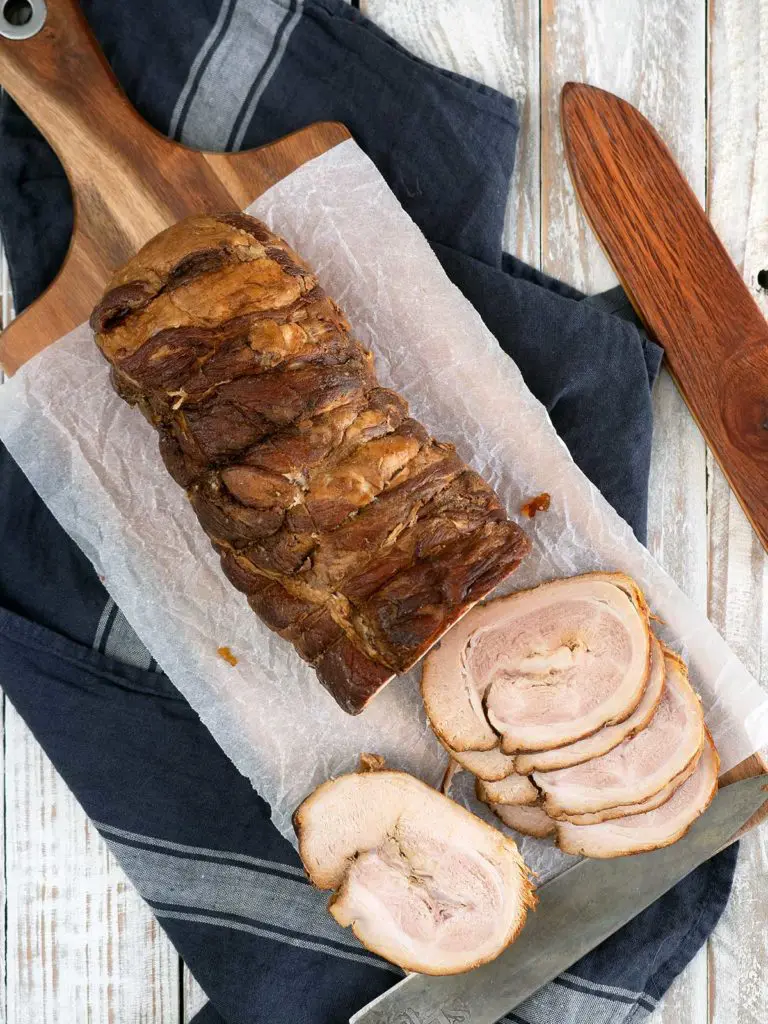
Any pork I am not going to use within a couple of days I freeze. To freeze sliced pork place on baking paper with a piece of baking paper between each slice. This prevents the slices sticking together.
As I use three slices at a time in my ramen, I freeze in lots of three slices. I still place baking paper between each slice to keep them separated on defrosting.
The chashu pork slices are then placed in a zip lock bag. Extract as much air as possible to help prevent freezer burn. I also store the chopped ends in an zip lock bag in the freezer.

Reheating the slices
There are various ways you can reheat slices of chashu pork. My preferred method is by fire, using a kitchen butane torch. The smell is incredible and adds a wonderful charred flavour to the chashu pork.
You can also reheat using a little of the braising sauce. Or simply place slices directly into your hot steaming bowl of ramen. If using from the freezer, defrost the pork first.
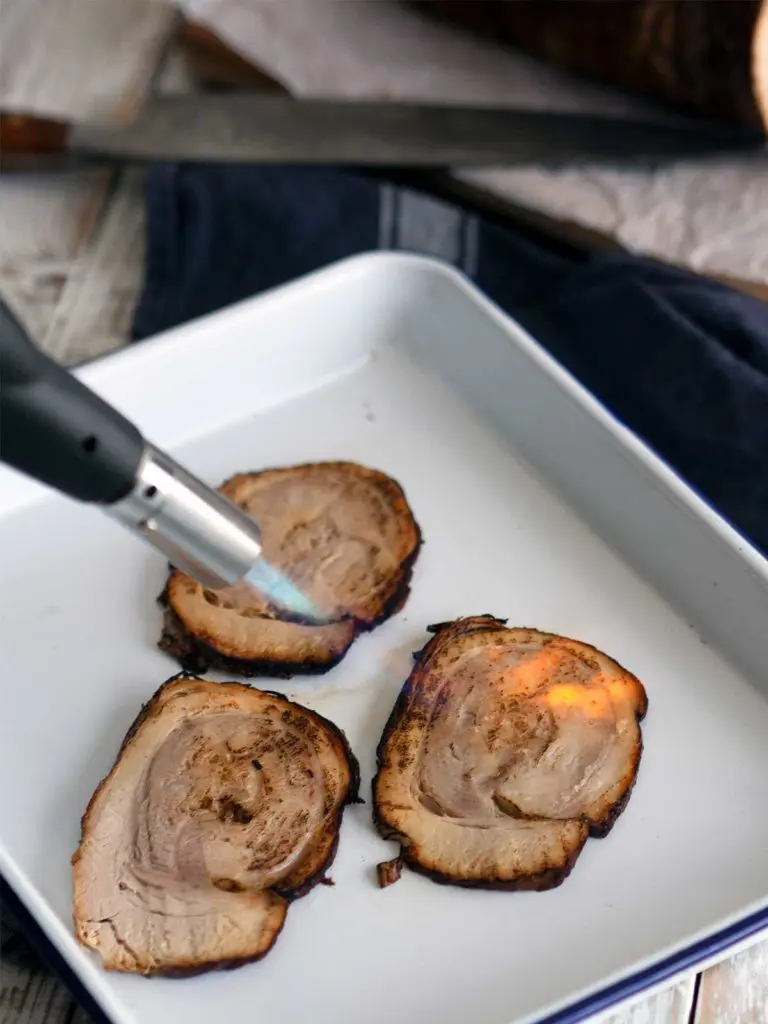
I do hope you enjoy this delicious chashu pork recipe as much as I do. It is a pure comfort dish and one that keeps giving. From the slices in the freeze to using the braising liquid for ramen eggs.
Sara xxx
Printable Recipe

Chashu Pork - Ramen Pork
Special Equipment
- large nonstick fry pan
- dutch oven with lid or large baking dish
- kitchen string
- chopping board + sharp knife
Ingredients
- 1.5 kg pork belly (bones and skin removed)
- 1 tablespoon vegetable oil
- 4 green onions (cut into thirds)
- 1 shallot (cut in half)
- 1 knob ginger (cut into rounds)
- 2 cloves garlic (bruised)
- 250 mls mirin
- 250 mls soy sauce
- 150 grams caster sugar
- 500 mls water
Instructions
- Preheat oven 160°C (320°F)
Preparing the Pork Belly
- Place pork belly on a cutting board underside up. Roll up tightly.
- Wrap kitchen string/butcher’s twin around one end of the rolled belly. Tie a double knot to firmly secure the string. Loop the string around the belly a finger spacing away from your initial knotted loop. Thread the string under the loop just created and pull tightly. Continue this until you come to the other end of the belly.
- Once the string has been wrapped around the pork belly you need to secure the ends. Loop the string over the end of the pork roll, tucking in the end of the pork. Run the string down the middle of the roll, threading the string through every few loops as you go, pulling tight.
- Do the same for the other side of the rolled and tied belly
Cooking the Pork Belly
- Add oil to a large nonstick frypan placed over medium heat. Put rolled pork belly in the frypan and brown all the surfaces. You aren't cooking it at this stage, simply trying to get good caramelisation.
- While the pork belly is browning add all other ingredients (including water) to a large dutch oven. Stir with a spoon until the sugar has dissolved.
- Place browned pork belly into the dutch oven with the braising liquid.
- Place lid on the dutch oven and place in the oven on the middle shelf.
- Cook for 40 minutes then turn the pork belly over and continue cooking. Continue turning the pork belly every 40 minutes for 3 hours and 20 minutes.
- Remove pork from the oven and turn one final time. Leave to rest with the lid on for 1 hour.
Rest & Set Chashu
- Remove pork from the braising liquid, set aside to cool slightly. Reserve the braising liquid, do not throw it away (see notes).
- When it is cool enough to handle wrap chashu tightly in a few layers of plastic kitchen wrap.
- Place chashu in the fridge overnight.
The Next Day
- Remove chashu from the fridge and take off the plastic wrap.
- Carefully remove the kitchen string from the chashu. Using a sharp knife cut. into 2-3mm (⅛ inch) slices. Reserve ends to use in another dish.
- Place slices of chashu on top of ramen and eat.
For storage and reheating please refer to below notes
Oven Temperatures
All oven temperatures are fan forced.
Measurement Notes
All measurements are Australian metric standard. All measures are level, and cups are lightly packed unless specified. 1 teaspoon = 5ml / 1 tablespoon = 20mls / 1 cup = 250ml /4 teaspoons = 1 tablespoon.
Recipe Notes
NUTRITIONAL INFORMATION
The recipe's nutritional information is an approximation based on an online calculator. It is meant solely for reference purposes. If you're looking for precise details, be sure to double-check with your own research.
Other Japanese recipes
Tori Karaage - tasty Japanese fried chicken
Japanese Rice Soup - a delicious distant cousin to congee
Agedashi Dofu - lightly deep-fried tofu
Teriyaki Chicken Wings - finger licking deliciousness




Richard
Hi Sara,
When is the Ramen Soup base recipe available, Tonkatsu Ramen
Is my absolute favourite. Just signed up to your site.
Cheers Richard
Sara McCleary
Hi Richard
Great to hear from you and thank you for signing up.
A ramen base recipe is on its way soon, I promise. It is well overdue.
Cheers, Sara
Angela
Delicious and perfect for ramen thank you!
Sara McCleary
Hi Angela, I am so glad to hear that you enjoyed it. It is a staple at our place for Ramen.
Jane
This was such a great recipe, but agree with the other comment. When are we getting a ramen soup base recipe???
Sara McCleary
Hi Jane, the ramen soup base is coming soon. I promise 🙂
Katie
Great recipe. But can you tell me how long can I store the braising liquid in the fridge? A week?
Sara McCleary
Hi Katie
I've kept it for a couple of weeks in the fridge. I store it in glass jars. We use it up pretty quickly making ramen eggs.
I think if treated well (no double dipping, clean utensils, etc) it will last at least 3 weeks in the fridge.
You could also freeze the leftover liquid in portions and defrost as needed for use.
Cheers, Sara
Tilly
Thank you Sara for another fantastic Japanese recipe. Will you be sharing a recipe for the ramen soup base in the future?
Sara McCleary
Hi Tilly, Yes I do have plans on sharing a ramen base soon.
Alice
I can't believe how easy this was to make at home. I followed your advice and now have a nice "stash" in the freezer.
Sara McCleary
Hi Alice, Glad you enjoyed it. I love having my stash of chashu in the freezer, comes in so handy.